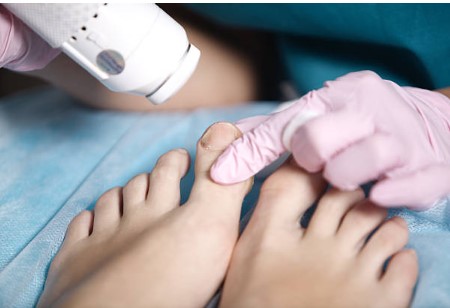How Effective Is Laser Toenail Treatment for Fungus?
How Effective Is Laser Toenail Treatment for Fungus?

Toenail fungus, medically known as onychomycosis, is a common condition that affects millions of people worldwide. It can cause your nails to become discolored, thickened, brittle, and even painful. Traditional treatments for toenail fungus, such as topical creams and oral medications, often have limited success and may come with unwanted side effects. In recent years, laser toenail treatment has emerged as a promising alternative. But how effective is laser toenail treatment for fungus? In this blog post, we will explore this question in depth, discussing how the treatment works, its benefits, success rates, and frequently asked questions.
What Is Laser Toenail Treatment?
Laser toenail treatment is a non-invasive procedure that uses focused light energy to target and destroy the fungus residing under and within the toenail. The laser emits a specific wavelength of light that penetrates the nail without causing damage to the surrounding tissue. This energy heats and ultimately destroys the fungal cells, allowing the nail to grow back clear and healthy.
How Does Laser Toenail Treatment Work?
Laser toenail treatment works by using the power of light energy to selectively target fungal cells. The laser passes through the nail and heats up the area where the fungus resides. This heat damages the fungal cells, making it difficult for the fungus to survive and spread. Over time, as the nail grows, the damaged portion is replaced with healthy, fungus-free nail.
The Benefits of Laser Toenail Treatment for Fungus
One of the primary advantages of laser toenail treatment is its non-invasive nature. Unlike oral medications, which can have systemic side effects, or topical treatments, which often struggle to penetrate the nail, laser therapy directly targets the source of the infection. Additional benefits include:
- No Recovery Time: Patients can resume normal activities immediately after the procedure.
- Minimal Discomfort: The procedure is typically painless, with most patients experiencing only a slight warming sensation.
- Quick Treatment Sessions: Each session usually lasts around 30 minutes.
- No Side Effects: Since it’s a localized treatment, there are no systemic side effects like those seen with oral antifungal medications.
Success Rates: How Effective Is Laser Toenail Treatment?
The effectiveness of laser toenail treatment fungus can vary depending on several factors, including the severity of the infection and the type of laser used. Studies have shown that success rates can range from 60% to over 80%. It’s important to note that, while laser treatment can significantly reduce the presence of fungus, it may not completely eradicate it in all cases. Multiple sessions are often required to achieve optimal results, and ongoing care may be necessary to prevent reinfection.
Who Is a Good Candidate for Laser Toenail Treatment?
Laser toenail treatment is suitable for most people suffering from toenail fungus. It is particularly beneficial for those who:
- Have Not Responded to Traditional Treatments: If topical creams or oral medications have been ineffective, laser treatment may offer a solution.
- Are Concerned About Side Effects: Patients who prefer to avoid the potential side effects of oral medications can consider laser therapy as a safer alternative.
- Desire a Non-Invasive Option: Those seeking a treatment that does not require surgery or other invasive procedures may find laser toenail treatment appealing.
What to Expect During Laser Toenail Treatment
During the laser toenail treatment session, your foot will be positioned so that the affected nail is exposed to the laser. The procedure typically involves:
- Preparation: The nail may be filed down to reduce thickness, allowing the laser to penetrate more effectively.
- Laser Application: The laser device is then aimed at the infected nail, and pulses of light are delivered.
- Post-Treatment Care: After the procedure, patients are advised to keep the treated area clean and dry. Follow-up sessions may be scheduled depending on the severity of the infection.
How Many Sessions Are Needed for Effective Results?
The number of sessions required for laser toenail treatment varies depending on the severity of the infection and the patient’s response to the treatment. Most patients require between 3 to 5 sessions spaced a few weeks apart. However, some patients may need additional sessions for stubborn infections. Consistency is key, and it’s essential to follow the treatment plan recommended by your podiatrist to achieve the best results.
Post-Treatment Care: Ensuring Long-Term Success
After completing laser toenail treatment, it’s important to follow a post-treatment care plan to prevent reinfection. This may include:
- Keeping Feet Dry: Fungus thrives in moist environments, so it’s essential to keep your feet dry.
- Wearing Breathable Footwear: Opt for shoes that allow air circulation and avoid tight, non-breathable footwear.
- Using Antifungal Powders or Sprays: These can help prevent fungal growth in your shoes and on your feet.
- Regular Check-Ups: Periodic visits to your podiatrist can help monitor the health of your nails and catch any signs of reinfection early.
Are There Any Risks or Side Effects?
Laser toenail treatment is generally considered safe, with minimal risks or side effects. The most common side effect is mild discomfort or a warm sensation during the procedure. In rare cases, some patients may experience temporary redness or swelling around the treated area, but these symptoms typically resolve quickly. Unlike oral antifungal medications, there is no risk of liver toxicity or drug interactions.
Comparing Laser Toenail Treatment to Other Options
When considering how effective laser toenail treatment is for fungus, it’s helpful to compare it to other treatment options:
- Topical Treatments: Creams and ointments often struggle to penetrate the nail, leading to lower success rates and prolonged treatment times.
- Oral Medications: While effective, these medications can have serious side effects, such as liver damage, and are not suitable for everyone.
- Surgical Removal: In severe cases, the nail may be surgically removed, but this is invasive and often painful.
- Laser Treatment: Offers a non-invasive, relatively pain-free option with promising success rates and no systemic side effects.
FAQs
Is Laser Toenail Treatment Painful?
- Most patients find laser toenail treatment to be pain-free, experiencing only a mild warming sensation during the procedure.
How Long Does It Take to See Results?
- It can take several months to see noticeable improvement as the nail grows out. Full results are usually visible within 6 to 12 months.
Can the Fungus Come Back After Treatment?
- While laser treatment can significantly reduce or eliminate the fungus, there is a chance of reinfection if proper foot care is not maintained.
Conclusion
Laser toenail treatment offers a promising solution for those struggling with stubborn toenail fungus. With its non-invasive nature, minimal side effects, and relatively high success rates, it has become an increasingly popular choice among patients and healthcare providers. While results may vary, laser therapy provides a safe and effective alternative to traditional treatments, helping patients regain healthy, clear nails.
At the Foot and Ankle Center of Arizona, we are committed to providing the best care possible for our patients. We believe that understanding your treatment options is crucial for making informed decisions about your health. If you have any further questions or would like to discuss laser toenail treatment in more detail, please contact our office or schedule an appointment through our website.









